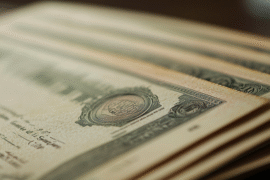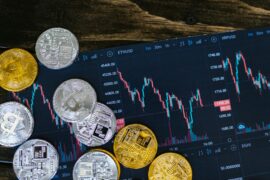This article may contain references to products or services from one or more of our advertisers or partners. We may receive compensation when you click on links to those products or services. Nonetheless, our opinions are our own.
Investing can be intimidating, especially for those who prefer to minimize risk. While aggressive investment strategies may promise higher returns, they are often volatile. Fortunately, a variety of options prioritize security and steady growth, making them well-suited for conservative investors.
We explore nine investment options designed to preserve capital while offering modest returns. Whether looking for income, diversification, or a hedge against inflation, these choices can help build a resilient portfolio with lower exposure to market fluctuations.
- 1. High-Yield Savings Accounts and Certificates of Deposit (CDs): Safe and Predictable Growth
- 2. Bonds: A Reliable Fixed-Income Investment
- 3. Dividend Stocks: A Balance Between Growth and Income
- 4. Index Funds and ETFs: Low-Cost, Diversified Investing
- 5. Real Estate: A Tangible Asset with Long-Term Growth Potential
- 6. Precious Metals: Preserving Wealth During Economic Uncertainty
- Final Considerations
- Recommended Reads
1. High-Yield Savings Accounts and Certificates of Deposit (CDs): Safe and Predictable Growth
High-yield savings accounts and CDs are excellent options for individuals who prioritize protecting their principal while earning modest interest. These investments are insured by the Federal Deposit Insurance Corporation (FDIC) or the National Credit Union Administration (NCUA) (up to $250,000 per account type), ensuring a high level of security.
- High-Yield Savings Accounts: These accounts offer higher interest rates than traditional savings accounts while providing easy access to funds. The returns may not outpace inflation, but are a secure way to store cash reserves.
- Certificates of Deposit (CDs): CDs offer fixed interest rates for a predetermined term, making them ideal for those who can commit to leaving their money untouched for a specific period. Early withdrawals typically result in penalties, but they provide a predictable return.
| Investment Type | Expected Returns | Liquidity | Risk Level |
|---|---|---|---|
| High-Yield Savings Account | 3-5% (variable) | High | Very Low |
| CDs | 4-6% (fixed) | Low | Very Low |
2. Bonds: A Reliable Fixed-Income Investment
Bonds are one of the most traditional low-risk investment options, providing predictable interest payments. These debt securities are issued by governments, municipalities, or corporations, and their risk level depends largely on the issuer’s creditworthiness.
- Treasury Bonds (T-Bonds): Issued by the U.S. Department of the Treasury, these bonds are backed by the federal government and considered among the safest investments available.
- Municipal Bonds: Issued by state and local governments, these bonds often provide tax-exempt interest, making them attractive for investors in higher tax brackets.
- Corporate Bonds: Offer higher yields than government bonds but carry slightly more risk, depending on the issuing company’s credit rating.
- High-Yield Bonds (Junk Bonds): While they promise higher returns, they come with an increased risk of default and should only be considered by those with a higher risk tolerance.
When investing in bonds, it’s essential to review the credit rating (AAA, AA, A, BBB, etc.) to assess the issuer’s financial stability.
3. Dividend Stocks: A Balance Between Growth and Income
Dividend-paying stocks allow investors to benefit from both stock appreciation and steady income. Unlike growth stocks, which focus on capital gains, dividend stocks distribute a portion of their profits to shareholders at regular intervals.
Key considerations when selecting dividend stocks include:
- Investing in blue-chip companies with a history of consistent dividend payouts.
- Seeking dividend aristocrats, companies that have increased dividends annually for at least 25 years.
- Understanding that dividends are subject to market fluctuations and may be reduced or eliminated during financial downturns.
Dividend stocks can be valuable to a diversified portfolio, offering long-term stability while generating passive income.
4. Index Funds and ETFs: Low-Cost, Diversified Investing
For those who prefer a hands-off approach to investing, index and exchange-traded funds (ETFs) provide a simple and cost-effective way to gain broad market exposure. These funds pool money from multiple investors to buy diversified assets, reducing reliance on individual stock performance.
- S&P 500 Index Funds: Track the performance of 500 large U.S. companies, offering broad market exposure.
- Total Market ETFs: Invest in thousands of companies across different sectors, further enhancing diversification.
- Bond ETFs: Provide exposure to a mix of government and corporate bonds, balancing stability and income.
| Investment Type | Diversification | Cost | Risk Level |
|---|---|---|---|
| S&P 500 Index Fund | High | Low | Moderate |
| Bond ETF | Moderate | Low | Low |
These funds typically have lower fees than actively managed mutual funds, making them a cost-effective option for long-term investors.
5. Real Estate: A Tangible Asset with Long-Term Growth Potential
Real estate investments have long been viewed as a stable option for wealth accumulation. While purchasing and managing properties require significant capital and effort, alternative real estate investments offer exposure with lower barriers to entry.
- Real Estate Investment Trusts (REITs): These companies own and operate income-generating properties, allowing investors to participate in the real estate market without owning physical assets.
- Crowdfunded Real Estate Platforms: These platforms pool funds from multiple investors to finance real estate projects, often requiring a lower initial investment.
- Rental Properties: Generating income through rent can be a steady source of passive income, though it requires active management and an understanding of market conditions.
Real estate can act as an inflation hedge, as property values and rental income often rise over time. However, illiquidity and market fluctuations should be considered before investing.
6. Precious Metals: Preserving Wealth During Economic Uncertainty
Precious metals like gold and silver have historically been used as a store of value, particularly during economic downturns. While they do not generate passive income, they can help preserve purchasing power during inflation.
- Gold: A widely recognized safe-haven asset that maintains value during financial instability.
- Silver: More affordable than gold and widely used in industrial applications, adding demand beyond investment purposes.
- Precious Metal ETFs: Provide exposure to gold and silver without requiring physical storage.
These investments tend to perform well when traditional markets are volatile but can experience long periods of stagnation.
Final Considerations
Investors who prefer to minimize risk have various options that prioritize stability while offering growth opportunities. To achieve financial security, a well-structured portfolio should include a mix of low-risk investments, income-generating assets, and inflation hedges.
Before making investment decisions, assessing risk tolerance, financial goals, and market conditions is advisable. Consulting with a financial professional or referring to reputable sources such as the Securities and Exchange Commission (SEC) or Financial Industry Regulatory Authority (FINRA) can provide additional guidance.
By carefully selecting the right combination of investments, a resilient portfolio that safeguards wealth while allowing for steady, long-term growth can be built.

Reviewed and edited by Albert Fang.
See a typo or want to suggest an edit/revision to the content? Use the comment form below for feedback.
At FangWallet, we value editorial integrity and open collaboration in curating quality content for readers to enjoy. Much appreciated for the assist.
Did you like our article and find it insightful? We encourage sharing the article link with family and friends to benefit as well - better yet, sharing on social media. Thank you for the support! 🍉
Article Title: 9 Investments for Cautious Investors
https://fangwallet.com/2025/03/31/high-yield-savings/The FangWallet Promise
FangWallet is an editorially independent resource - founded on breaking down challenging financial concepts for anyone to understand since 2014. While we adhere to editorial integrity, note that this post may contain references to products from our partners.
The FangWallet promise is always to have your best interest in mind and be transparent and honest about the financial picture.
Become an Insider
Editorial Disclaimer: The editorial content on this page is not provided by any of the companies mentioned. The opinions expressed here are the author's alone.
The content of this website is for informational purposes only and does not represent investment advice, or an offer or solicitation to buy or sell any security, investment, or product. Investors are encouraged to do their own due diligence, and, if necessary, consult professional advising before making any investment decisions. Investing involves a high degree of risk, and financial losses may occur including the potential loss of principal.
Source Citation References:
+ Inspo
There are no additional citations or references to note for this article at this time.












































